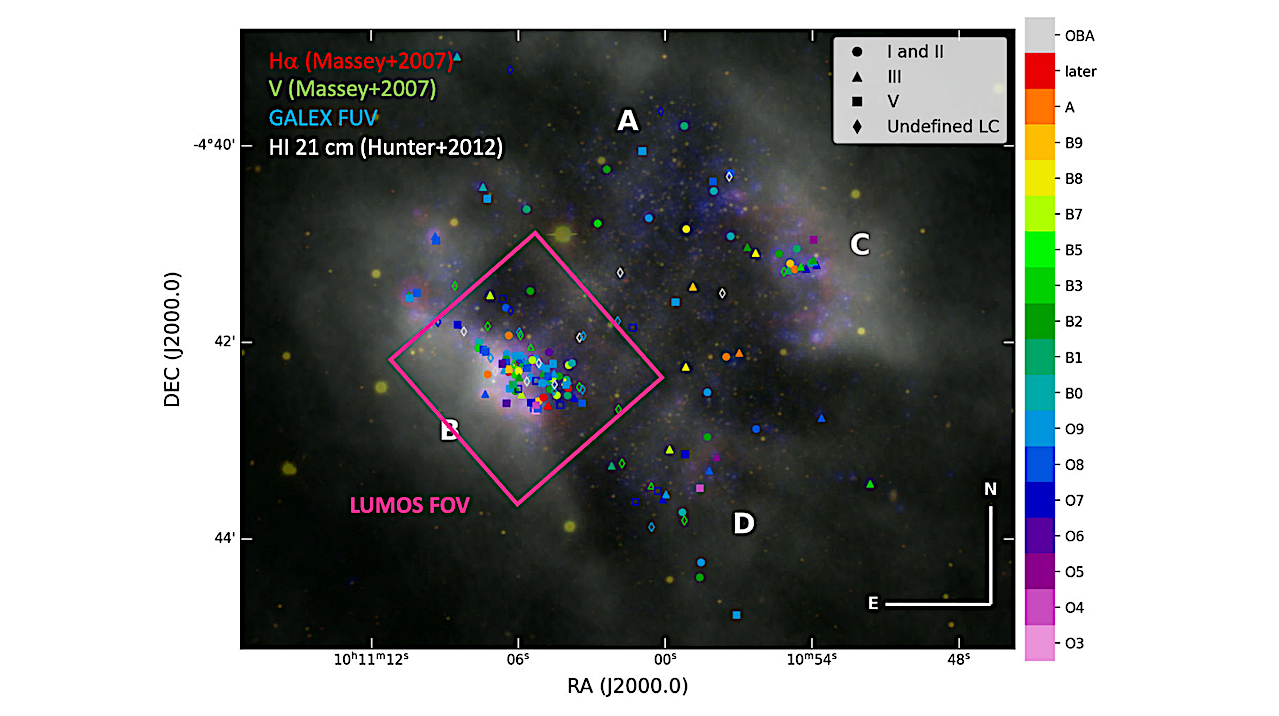(From Lorenzo et al. (2022)) RGB composite image of Sextans A made with Hα (red) and V bands (green) from Massey et al. (2007), and GALEX FUV (blue). The LITTLE THINGS neutral hydrogen map (Hunter et al. 2012) is overlaid in white. OB stars catalogued in Lorenzo et al. (2022) are color-coded according to their spectral type and with different symbols based on their luminosity class. The LUMOS field-of-view is overlaid. In 100h, HWO could obtained FUV and NUV spectra of most of the stars shown in this image with S/N > 20. — astro-ph.GA
The cycle of metals between the gas and the dust phases in the neutral interstellar medium (ISM) is an integral part of the baryon cycle in galaxies.
The resulting variations in the abundance and properties of interstellar dust have important implications for how accurately we can trace the chemical enrichment of the universe over cosmic time.
Multi-object UV spectroscopy with HWO can provide the large samples of abundance and dust depletion measurements needed to understand how the abundance and properties of interstellar dust vary within and between galaxies, thereby observationally addressing important questions about chemical enrichment and galaxy evolution.
Medium-resolution (R~50,000) spectroscopy in the full UV range (950-3150 A) toward massive stars in Local Volume galaxies (D < 10 Mpc) will enable gas- and dust-phase abundance measurements of key elements, such as Fe, Si, Mg, S, Zn. These measurements will provide an estimate of how the dust abundance varies with environment, in particular metallicity and gas density.
However, measuring the carbon and oxygen contents of dust requires very high resolution (R > 100,000) and high signal-to-noise (S/N > 100) owing to the non-saturated UV transitions for those elements being extremely weak. Since carbon and oxygen in the neutral ISM contribute the largest metal mass reservoir for dust, it is critical that the HWO design include a grating similar to the HST STIS H gratings providing very high resolution, as well as FUV and NUV detectors capable of reaching very high S/N.
Julia Roman-Duval, Yumi Choi, Mederic Boquien
Comments: 12 pages; 6 figures; will be published in ASP conference proceedings of the HWO2025 conference
Subjects: Astrophysics of Galaxies (astro-ph.GA)
Cite as: arXiv:2507.00201 [astro-ph.GA] (or arXiv:2507.00201v1 [astro-ph.GA] for this version)
https://doi.org/10.48550/arXiv.2507.00201
Focus to learn more
Submission history
From: Julia Roman-Duval
[v1] Mon, 30 Jun 2025 19:10:27 UTC (663 KB)
https://arxiv.org/abs/2507.00201
Astrobiology

